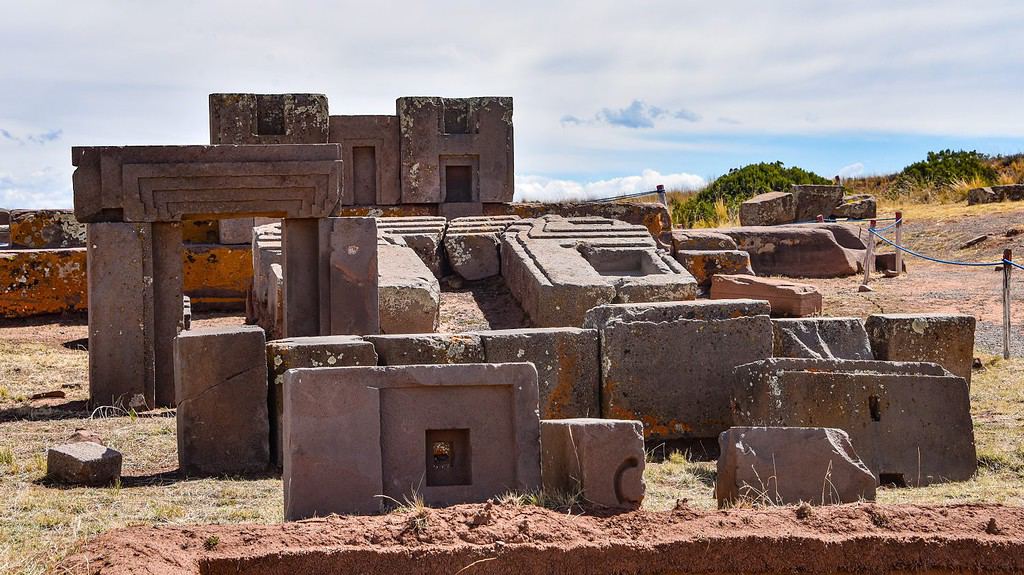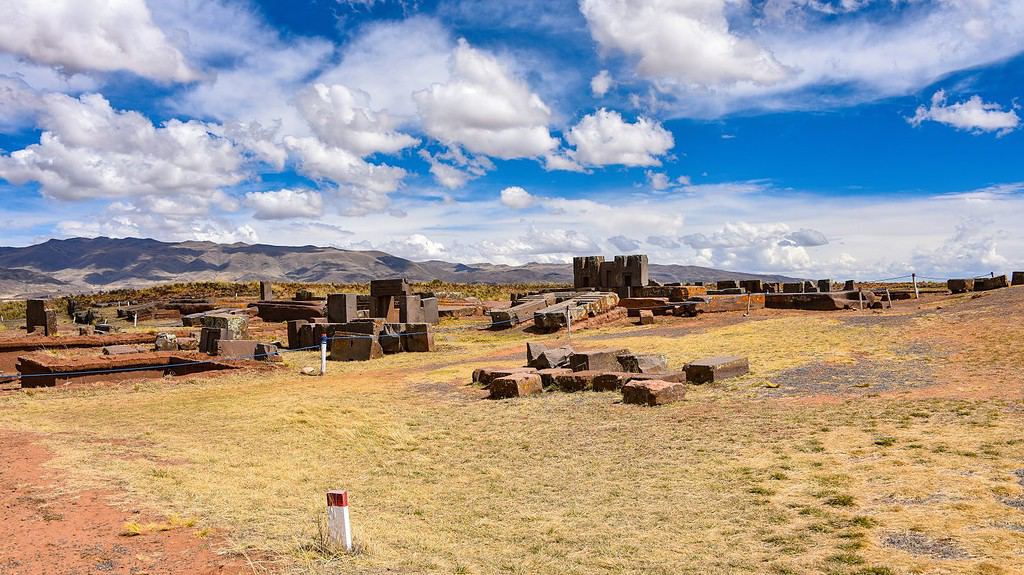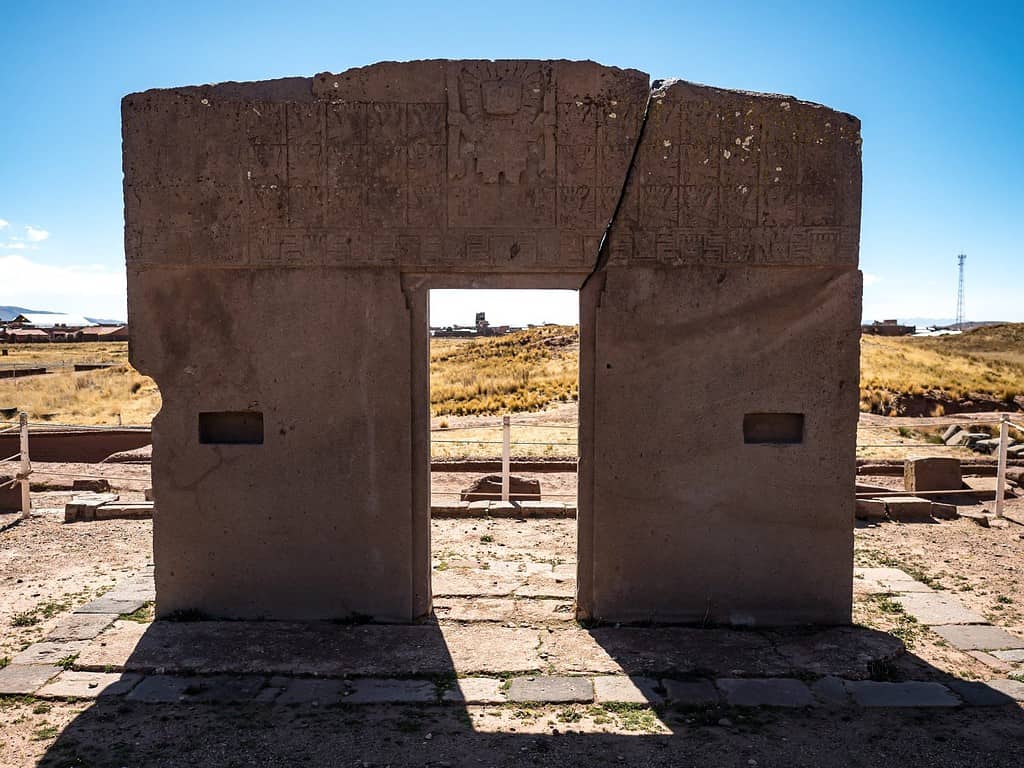The mystery-laden Puma Punku stones lie ruined in the Bolivian jungle, 45 miles west of La Paz on a pre-Incan Tiwanaku-era archaeological site. Puma Punku means “Door of the Puma,” but little else is known about these epic stones and the greater ancient landscape they lie in. Here are 7 reasons the stones of Puma Punku are among the Earth’s coolest mysteries.
Mysterious Laser Precision Stone Work

Puma Punku’s stones look like poured reinforced concrete.
©Mark Green/Shutterstock.com
The most fascinating wonder about the Puma Punku stones is the incredible stonework. Even though the site is in ruins, long ago abandoned by the Tiwanaku, the stones’ flat, smooth faces, sharp linear edges, and modern lines appear current-day. Baffled experts don’t understand how an ancient civilization managed to create such precise tooling.
Puma Punku’s red sandstone and andesite stones are not soft but cut as if a modern-day diamond tool chiseled them out. Some stones link together to form load-bearing joints that lock without fixtures, so some experts suggest mold-pouring, like prefabricated concrete blocks. However, this kind of technology isn’t known elsewhere at that period.
No one knows for sure just how the Puma Punku stones were tooled. It’s a cool mystery that archaeologists, historians, and modern stone masons still argue over.
They Weigh Tons, So How Did The Stones Get There?

Puma Punku’s largest stone weighs approximately 144 short tons.
©Mark Green/Shutterstock.com
Puma Punku’s behemoth megalith stones weigh incredible amounts. Many of the large stones weigh several tons each. The very largest remaining stone is a red sandstone block that measures 25.6 feet long by 17 feet wide and three feet thick. It weighs approximately 144 short tons.
The site is at 12,800 feet altitude, above the tree line, but no machinery or evidence of a transport system remains on site (looters removed a lot of the site’s resources over the centuries). So, just how did the gigantic stones arrive there, and how did they end up in such a ruinous state?
No one knows for sure! Archaeologists argue that a large workforce dragged the stones to the site using ropes and ramps. A few of the more radical historians suggest large machines shifted the stones, but there’s no evidence to back up either theory. In fact, archaeologists haven’t discovered a single tool.
Experts Don’t Know What It Was For

Only a small portion of this archaeological site is uncovered.
©Dmitry Burlakov/Shutterstock.com
Puma Punku’s site is the size of two football fields, and its amazing stones lie scattered on the ground. Archaeologists have also found huge stepped platforms, grand enclosures, a semi-subterranean pyramid, homes, an irrigation system, and an advanced waterproof sewage system there.
Geographical Information Systems (GIS) and drone mapping of the surrounding area discovered that only two hectares of a 17-hectare site are currently uncovered. At least two more buried stepped platforms await archaeologists’ trowels.
Was Puma Punku a religious site, a town, or something else entirely? How big was it? It’s a mystery!
Or How Old It Is

Radiocarbon testing puts Puma Punku’s age from 536-600 A.D.
©huaidanphotography/Shutterstock.com
Most experts agree Puma Punku stones and the surrounding complex date to 500-600 A.D., but not everyone agrees.
In 1926, Austrian archaeologist Arthur Posnansky, one of the first archaeologists on site, dated the remains to be 15,000 years old. He believed the Tiwanaku complex was a huge clock built according to the stars. By his calculations, the main buildings match the sunrise and astronomical patterns only seen 15,000 years ago. A few modern-day archaeologists support this theory.
The most recent radiocarbon test dated a deep layer of mound fill created during the very first of three construction eras. Results indicated the construction of Puma Punku began in 536-600 A.D.
A Space For Psycho Enhancement and Murders?

Mummified remains at Puma Punku suggest that all age ranges took psychoactive substances.
©Andrea Izzotti/Shutterstock.com
Historians and archaeologists don’t know much about the Puma Punku stones, but their wider landscape and the Tiwanaku people were important.
The people that lived there used vast Lake Titicaca’s water, a critical resource in the area, and their empire stretched across modern-day Chili, Peru, and Bolivia. Puma Punku’s incredible engineers built irrigation systems, waterproof sewage ways, and spaces beneath the ground. Many unearthed mummies, including children and the elderly, show signs of ingesting hallucinogenic plants, and evidence for ritualized murders has raised its head.
The people of Tiwanaku are just as interesting as the Puma Punku stones they made.
Alien Theories Abound

Some people believe Puma Punku stones were designed by an alien race.
©vchal/iStock via Getty Images
Because the construction of the Puma Punku stones isn’t understood yet, alien theories permeate its legend.
The main evidence put forward by alien enthusiasts is a lack of similar stones in the local area or, indeed, anywhere else in the world. Couple this with the lack of definite earthly theory, and extra-terrestrial technology theories abound.
Did aliens build Puma Punku? Some folks think so.
Mysterious Abandonment of Puma Punku

Residents left Puma Punku around 1,000 A.D.
©Adwo/Shutterstock.com
Despite its grandeur, historians think people abandoned the Tiwanaku complex and its Puma Punku stones in approximately 1,000 A.D, but no one knows why for sure.
Theories suggest a drought forced inhabitants out of the water-reliant complex. Other theories suggest a tidal wave or a massive earthquake destroyed the area, which would explain fallen stones that weigh hundreds of tons.
A few experts believe an invasion or civil war forced communities to neighboring towns, and others suggest that internal societal breakdown led to a gradual but persistent exodus.
Nobody knows for sure, but when conquering Incans arrived in the 1400s, a lifeless Puma Punku greeted them. However, the Incans incorporated the area into their building program, hailing it as the site where all life began.
The photo featured at the top of this post is © Mark Green/Shutterstock.com
Thank you for reading! Have some feedback for us? Contact the AZ Animals editorial team.






